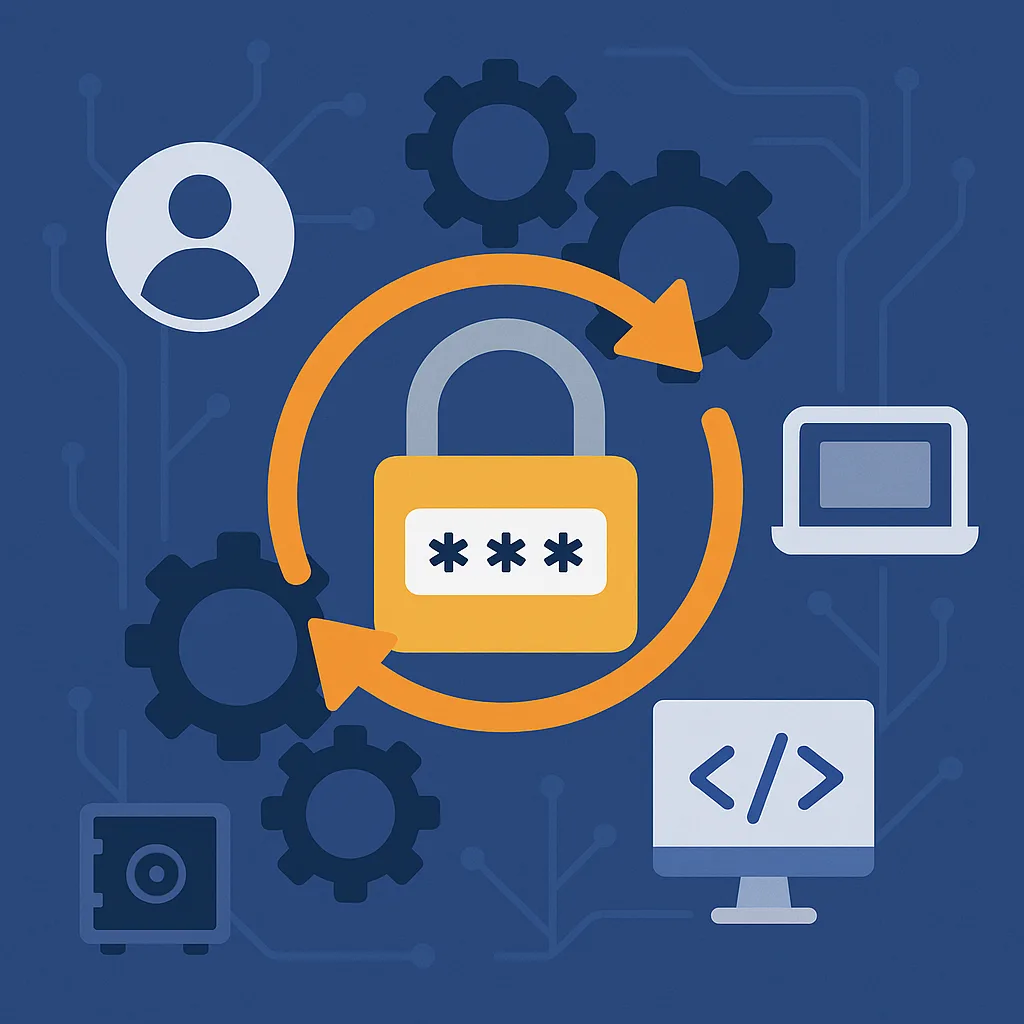Service accounts are often the unsung workhorses in an organization—running services, scheduled jobs, backend automations. Yet because they’re often “set and forget,” their credentials remain static for long periods, posing significant security risks. Automating the password rotation for service accounts is a critical defense against credential theft, lateral movement, and insider threats.
In this article, we explore how to design, implement, and maintain a reliable system for automatically rotating service account passwords, ensuring dependencies are updated, downtime is minimized, and security is maximized.
Why Automate Service Account Password Rotation?
- Minimize risk window: A stolen credential is only useful until it changes.
- Reduce human error: Manual changes often miss places where service account credentials are stored (services, scripts, config files).
- Ensure consistency & compliance: Many compliance regimes or security policies expect regular credential updates.
- Prevent credential reuse and stale passwords.
Key Requirements & Challenges to Address
- Knowing where every service account is used (services, scheduled tasks, application configs, stored credentials).
- Ensuring all services using the account are updated when password changes.
- Avoiding downtime caused by failing services that still hold old passwords.
- Securely storing newly generated passwords.
- Audit and logging of rotation events.
- Secret strength (complexity) and policy enforcement.
Steps to Automate Rotation
Here’s a generalized workflow to engineer password rotation automation for service accounts.
Step 1: Inventory & Mapping
- Enumerate all service accounts in use (Windows, Linux, domain/local, cloud service principals).
- Identify all dependencies: which services, applications, scripts, scheduled tasks or containers rely on each account.
- Map where the password is stored (configuration files, secrets vaults, service properties).
Step 2: Choose a Secrets / Credential Management Solution
You need a reliable mechanism to generate, store, retrieve, and update passwords securely.
- Use a secrets vault: tools like HashiCorp Vault, Azure Key Vault, AWS Secrets Manager, or an on‑prem vault.
- The vault must support: strong password generation, access control, versioning, audit logging, integration/automation APIs.
Step 3: Define Rotation Policy
- Set rotation frequency (e.g., every 30, 60, 90 days) depending on risk and criticality.
- Define password complexity rules.
- Define whether rotation is automatic or requires validation.
- Ensure policies account for services that may require manual intervention (legacy apps, where config cannot be automatically updated).
Step 4: Automate the Password Change
- Generate new password via vault or automation tool.
- Set the new password in secrets vault or managed store.
- Update all dependencies:
- For Windows services: Change “Log On As” credentials for service.
- For scheduled tasks.
- For application configuration files or containers.
- For cloud service principals or API‑keys where relevant.
- Restart or reload services if needed.
Step 5: Validate & Rollback
- After rotation and updates, verify that all services/applications that depend on the service account still function correctly.
- Have rollback plan: if something breaks, revert to prior password or disable new password till fix.
Step 6: Logging, Monitoring & Alerting
- Log every password generation, update, and deployment event.
- Monitor for failures: services that fail to start, authentication failures, error logs referencing service account credentials.
- Alert when rotation fails or partially succeeds.
Hidden / Less Obvious Best Practices
- Use temporary “shadow” credentials (or dual credentials) during rotation to reduce downtime: generate new creds while old creds still accepted briefly, then switch fully.
- Use ephemeral credentials or certificate‑based identities when possible instead of long‑lived static passwords.
- For cloud service accounts, using roles or short‑lived tokens reduces exposure.
- Automate credential discovery: detect where service accounts are stored, perhaps by scanning config files, service definitions, environment variable references.
- Ensure vault access is tightly controlled (least privilege), and rotation automation mechanism itself is secured.
- Test the full chain – for example, after password update, test from the application consuming it, not just change and assume.
Example Automation Script / Pseudocode
Here’s a pseudocode outline (platform‑agnostic) of how this might work:
For each serviceAccount in serviceAccountList:
newPassword = vault.GenerateStrongPassword(policy)
vault.StoreSecret(serviceAccount, newPassword)
for each dependency in serviceAccount.Dependencies:
if dependency.Type == “WindowsService”:
updateServiceLogonCredential(dependency.Host, serviceAccount, newPassword)
else if dependency.Type == “ConfigFile”:
replaceCredentialInConfig(dependency.FilePath, serviceAccount, newPassword)
else if dependency.Type == “CloudServicePrincipal”:
updateCloudServicePrincipalCredentials(serviceAccount, newPassword)
end
restartAffectedServices(serviceAccount.Dependencies)
logRotationEvent(serviceAccount, timestamp, success/failure)
end
Common Pitfalls & How to Avoid Them
| Pitfall | Consequence | Mitigation |
|---|---|---|
| Forgetting some dependency (e.g. config file or script) | Service failures, outages | Thorough inventory; automated discovery; test rotations in staging |
| Poor password complexity or reuse | Weak security; risk of compromise | Enforce strong, unique password policies; avoid shared passwords |
| Rotation frequency too aggressive | Risk of disruption; overhead | Tailor frequency based on risk; use shadow credentials to transition |
| Storing passwords insecurely (plain text, unencrypted) | Compromise risk | Use vaults; encrypt at rest; restrict access |
| Rotation scripts without proper error handling | Partial failures, inconsistent state | Check return codes; ensure script retries; rollback plan |
Security & Compliance Considerations
- Use least privilege for any accounts that perform rotation.
- Ensure that rotation secrets and vault services themselves are audited and secure.
- Maintain audit trails for compliance: who rotated which account when.
- If applicable, align rotation policies with regulatory requirements (PCI, HIPAA, etc.).
Conclusion
Automatic service account password rotation is a powerful guardrail in security architecture. It reduces risk, enhances auditability, closes windows of exposure, and improves compliance. The challenge is in making it reliable: identifying dependencies, ensuring updates without downtime, securing your secrets management, and monitoring for failures. But done right, you get strong credential hygiene and much greater confidence in your service account security.


